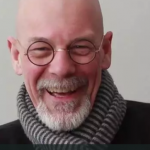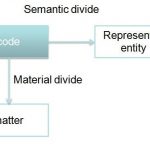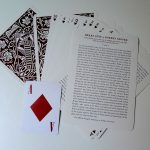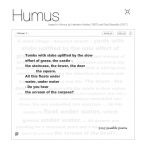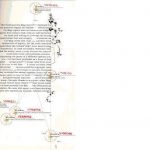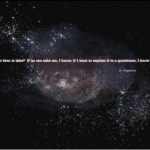2012
The good news in Alex Link's review is that Karin Hoepker's No Maps for These Territories begins the necessary work on spatiality in William Gibson's first two trilogies. Still, much remains to be done. Link points the way to a critically productive analysis built on Hoepker's opening moves.
Steve Tomasula in Conversation with Jhave. Recorded at the Banff Centre, Alberta, Canada. 2012-02-21.
Hans Kristian Rustad sympathizes with Curtis White's "latest word." White diagnoses a crisis in contemporary literature in the "Amazonian" monolith dominating the online book industry. Still, Rustad questions White's lack of attention to electronic literature. For Rustad, elit may "save literature from market-oriented book houses that evaluate books by potential profits."
Serge Bouchardon and Davin Heckman put the digit back into the digital by emphasizing touch and manipulation as basic to in digital literature. The digital literary work unites figure, grasp, and memory. Bouchardon and Heckman show that digital literature employs a rhetoric of grasping. It figures interaction and cognition through touch and manipulation. For Bouchardon and Heckman, figure and grasp lead to problems of memory - how do we archive touch and manipulation? - requiring renewed efforts on the part of digital literary writers and scholars.
Yra van Dijk calls for a return to the text, for a criticism of digital literature that moves past foundational work on the new form and seriously engages with the work itself. In Roberto Simanowski's Digital Art and Meaning and in the edited collection Reading Moving Letters, van Dijk finds a return engagement with deep meaning and with criticism as a site of intentional human experience, and not of heavy theory or machinic spectacle.
Zuzana Husárová and Nick Montfort up the ante for experimental writing by examining the category of "shuffle literature." What is shuffle literature? Simply put: books that are meant to be shuffled. Using formal reading of narrative and themes, but also a material reading of construction and production, Husárová and Montfort show that there are many writing practices and readerly strategies associated with this diverse category of literature.
Rui Torres tracks the practice of intertextual borrowing or "plagiotropia" between the works of Portuguese experimental poets. Plagiotropia is a tangible and fecund practice in digital poetry, where poetic texts migrate and grow across media. Torres' arguments culminate in an examination of his own online combinatory cyber-poetry, which creatively re-writes earlier pre-digital experimental works.
Lila Marz Harper shows the many dimensions of intertextuality between Edwin Abbott's Flatland and Steve Tomasula's VAS. From typography to narratology, Tomasula's "opera in flatland" follows Abbott, in a geometry of fiction that interrogates the biopolitics of today.
Is literature a medium for handling our fears? Anne-Laure Tissut argues that the polysemous multimedial procedures of Steve Tomasula's VAS collapse body and text in a way that both amplifies and cushions fears of mortality, instability, and otherness.
House of Leaves may be on everyone's shortlist of postmodern media-savvy novels, but are we ready for a retrospective collection of essays on Mark Z. Danielewski? According to Daniel Punday's review, Joe Bray and Alison Gibbons' collection says as much about the current state of (post) postmodernist writing as it does about Danielewski's scant oeuvre.
Like a text whose every rewriting is a reinterpretation, the body changes each time its "naturalness" is re-articulated anew. This is the spiraling history traced by Steve Tomasula’s VAS, which depicts the body, according to Alex Link, as "the place where cultural work is naturalized, and where the natural is worked."
Katherine Hayles uses Steve Tomasula's multimodal TOC for a significant engagement with the temporal processuality of complex technical beings. Drawing on Bergon's "duration" and its elaboration in recent theories of technicity and consciousness, Hayles explores the complex temporal enfoldings of living and technical beings, showing that Tomasula's new media novel narrates and materially embodies such assemblages.
Steve Tomasula's TOC is hard to explain, according to Alison Gibbons. You're better off experiencing it in all its multimodal and multimedial complexity. Using human computer interaction and narrative theory, Gibbons shows that the emergent, singular, fractured temporality of reading TOC raises the bar for the new media book.
Can a corporate-dominated Web become an environment conducive to literary activity? The novelist, essayist, and cultural critic Curtis White is skeptical. Responding to criticisms of his account of the devolution of literary publishing and reflecting on the prevalence of market-driven values in online exchanges, White doubts whether literature can distinguish itself in the noisy new media ecology, which he likens to a high-tech prison house.
Kate Pullinger's response to Curtis White's "The Latest Word" ploughs ahead. She tells us that writers today may fear for the future of literature but they keep writing, they go on, they must go on.
No need to get excited. According to Julie Reiser, The Affect Theory Reader offers the reader no end of theory but little affect. Reiser suggests this points to a broader and systemic problem in any reading or theory of affect.
Stephen Ramsay introduces a short film in which he does a live reading of composer Andrew Sorensen's performance "Strange Places" and provides commentary.
David Shepard heads off the discussion regarding Stephen Ramsay's live reading of Andrew Sorensen's "Strange Places." His initial contribution is followed with posts by Amanda French, Mark Marino, Max Feinstein, Jeremy Douglass, Daren Chapin, John Bell, Jeff Nyoff, Jennifer Lieberman, and Stephen Ramsay, as well as Andrew Sorensen himself.
This formulation by Joseph Tabbi is being reprinted with permission from the University of Minnesota Press's remixthebook. The original online version can be found here.
In this riposte, Marie-Laure Ryan suggests Lisa Swanstrom has 'flattened' the dimensions of her arguments about digital narrative as well as the dimensions of the digital experience itself.
